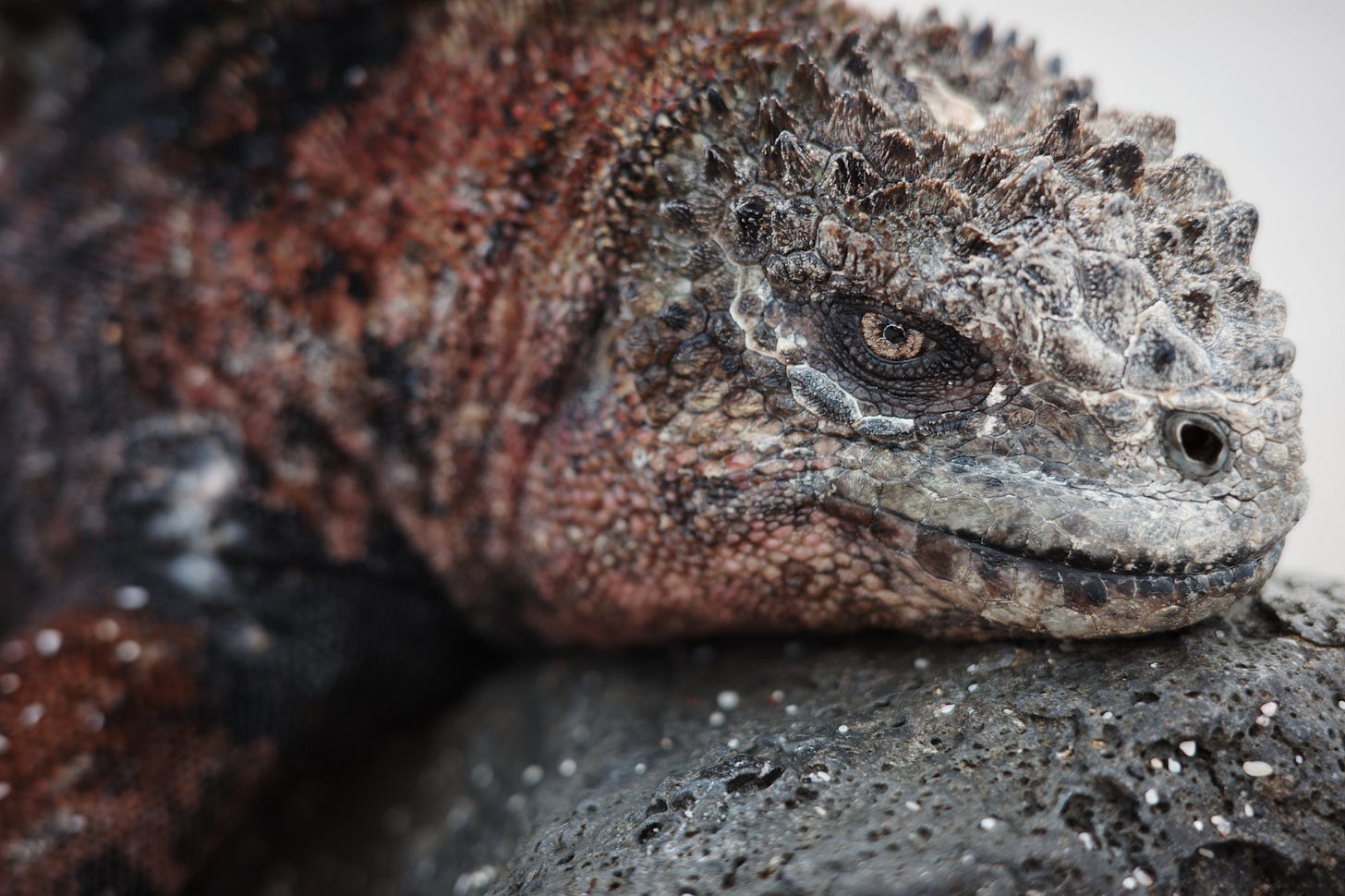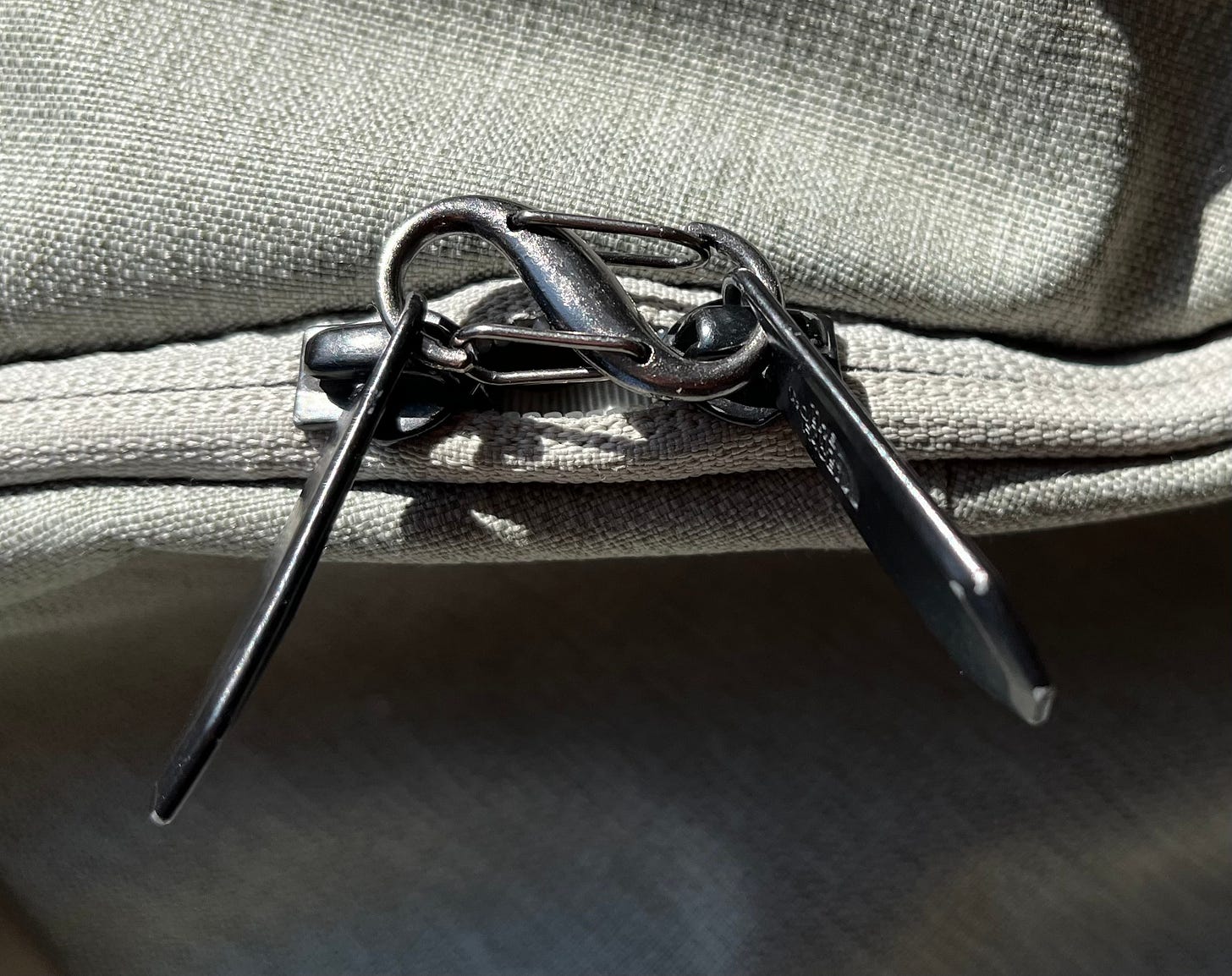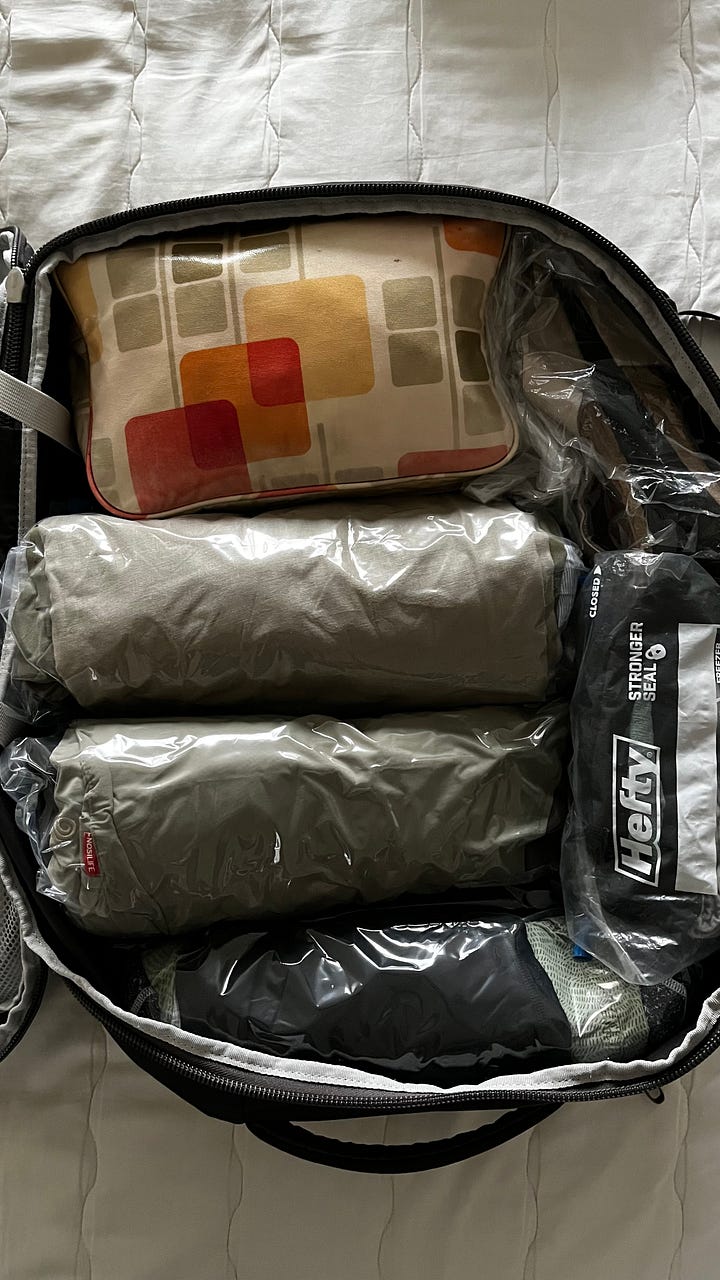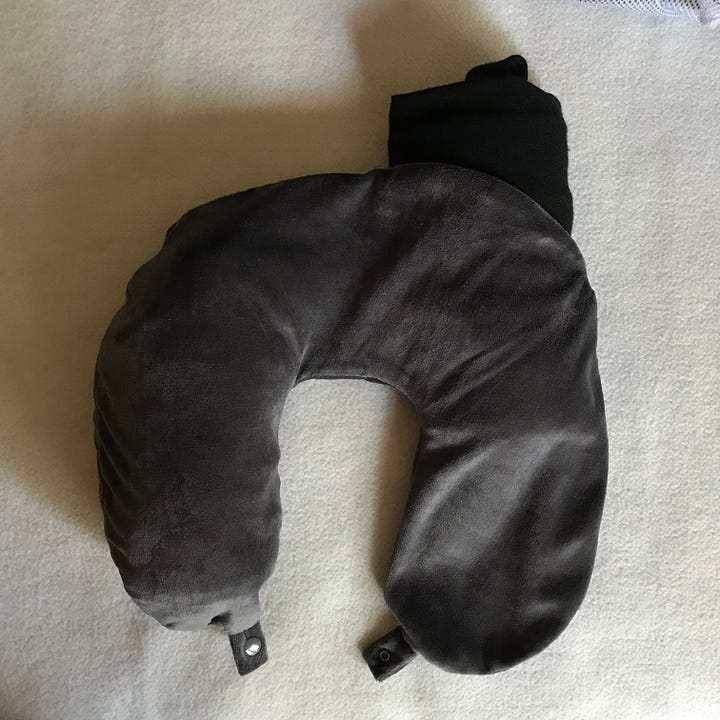🔎 How We Prepared for Our Journey to the Galápagos Islands
On packing light, overthinking things, and staying safe
It’s happening! As I’m writing this we’re in Quito, the capital of Ecuador, and when you’re reading this, we’re on the Galápagos Islands.
Once there, we won’t immediately blow our budget on a short luxury cruise like the majority of tourists. We will lodge instead in a self-sustainable house on a cacao farm so we can stay for over a month. Picking breakfast papayas from the trees and staring at the sky at night is going to be part of the experience.
Daniel and I have been nomadic for nearly six years, yet we still prepare for each trip, because each destination has different challenges and requirements. While I was talking to friends about getting ready, feeling stressed about everything I still had to do, I realized this process was worth sharing with you all. (And thanks, Ororo, for your vote last week!)
Here’s how Daniel and I prepared for our travels to the Galápagos Islands.
Please note: these 8 steps are concurrent, not chronological.

1. Researching the basics—months in advance
Are our passports still 6 months valid at the time of our arrival? Yes. Do we need a visa? Not for US and European citizens who stay less than 90 days. Do we need a flight out of Ecuador to prove we intend to leave on time? Yes. So where should we go next?
I read many online articles and downloaded some travel guides from the library. I also contacted online acquaintances who were recently in South America. Where did they go? What are their recommendations? Did they feel safe? How was the mosquito situation?
Among other things, I learned this:
Colombia is an amazing country and I can safely travel there if I take some extra precautions, such as not pulling my phone out in public or wearing expensive-looking clothes.
Quito has a beautiful old center that is worth exploring, but walking around after dark is unwise.
Mosquitos on the Galápagos exist, as they do nearly everywhere in the world, but they’re not a huge nuisance. There’s no dengue outbreak on the islands.
It costs $200 per person to enter the Galápagos and it must be paid in cash in US dollars—Ecuador’s official currency.
There are power shortages and blackouts in Ecuador, and it’s smart to bring a flash light and power bank. Some hotels have their own generators, others do not.
February is the start of the rainy season in the Galápagos, but this doesn’t mean it will rain all the time. It just means some rain is to be expected. It’s also the period in which the water is warmest and calmest, so ideal for people like me who love to snorkel.
All this research helped me overcome my fears.
2. Checking vaccinations and health insurance coverage—months in advance
I checked the vaccination recommendations for South America, our vaccination records, and the vaccination requirements for Ecuador (none). After our doctor’s visit this summer in Amsterdam, we were up to date on nearly all recommended shots. Getting a yellow fever vaccine wasn’t necessary for the Galápagos, but because we considered going into the Amazon rain forest while in Colombia, we got our yellow fever vaccines from a doctor catering to expats in some suburb in Florence.
We also wanted to get a dengue vaccine, but that required two shots three months apart. We didn’t have enough time left in Europe and the vaccine wasn’t yet approved in the USA. Not every health agency recommended the vaccine for people who’d never had the disease before. So for now, we’ve let this idea go.
Because of changes in our personal situation, I had to compare international health insurance plans and read the fine prints—that took some time! The result is that we’re better covered now than we were before except for in the USA. I might write about this subject later. In the mean time, please read this excellent post by Brent and Michael.
3. Making actual travel arrangements—weeks to days in advance
First, we looked for accommodations on multiple platforms and landed on a house on Santa Cruz, one of the habited Galápagos Islands. I arranged our stay there with the host, discussing online payments and the possibility of renting bicycles. Then we booked our flight to Quito using a soon expiring trip credit. Weeks later, when it became more and more likely that we would go through with our plans, we booked the hotel in Quito, the flight to the Galápagos, researched the ferry schedule and activities, booked an apartment on San Cristobal (another Galápagos island, our first destination), and organized the pickups from airports and ferry docks with trusted drivers. Finally, we booked our obligatory flight out of Ecuador and decided on Medellín, Colombia. Our last week on the Galápagos in March remains open: We will book tours and accommodations after we get the lay of the land.
4. Buying location specific items (secondhand as much as possible)—weeks to days in advance
Usually, we buy what we need in the place we need them, but supplies on islands 1,000 km (620 miles) away from the mainland are probably going to be limited. Our host on Santa Cruz told me what products we could buy locally, and I decided to bring the following:
Reef-safe sunscreen—this is important, for the reefs and animals and for us. Update after arrival: Our luggage was scanned for cosmetics, sunscreen, or aerosol bug sprays; nothing was confiscated at the airport as some blogs had led me to believe. But when you’re swimming with sea lions and turtles, you may want to wear sunscreen that hurts them and the reefs the least.
DEET-free mosquito repellent—I like my (p)icaridine and eucalyptus repellents better and they’re (according to locals) not so readily available there.
Snorkeling mask and snorkel—you can rent them per day, but the quality is not great and it will get pricy if we’re there for over a month.
UV protective clothing, legging and rash guard—the Galápagos are on the equator.
The Galápagos Islands are not a dangerous destination, but petty theft on mainland Ecuador and in Colombia is common, so we bought some extra gear to protect ourselves.
Portable safe—most budget hotel rooms don’t have safes
Bra wallet—when I attach this to the front of my bra I cannot even feel it’s there
Belt wallet—Daniel will wear this on the inside of his pants; it’s like an extra invisible pocket
Travel underwear with secret pockets—great for underneath a skirt
S-biners—so we can clip the zippers of our backpacks shut and make them harder to open in public transportation
RFID blocking sleeves—are these really necessary? Are we overthinking things? They supposedly protect our passports and cards from being scanned.
Better (more visible) wrist straps for our phones and camera—we won’t use our gear on the street, but in case we must, a strap prevents things from being grabbed out of our hands.

5. Reading more and getting excited—always
I browsed blogs and Substack newsletters. I borrowed the Moon Guide to the Galápagos Islands and started reading John C Kircher’s Galápagos—a natural history. What treasures await us!
6. Selecting what we bring with us—days in advance
I have a lot to share on this subject, and most of it isn’t specific to the Galápagos. So skip to step 7 or 8, if this doesn’t interest you.
Daniel and I travel light with carry-on luggage only. I have a 44L Osprey backpack and a small North Face daypack that I wear on my chest when I move between accommodations. Daniel has a 28L Fjällräven backpack and a sling pack.
We travel light because:
We want to be as mobile as possible. Walking for 20 minutes should be okay.
We don’t want to check our luggage. We don’t want to wait for dropping bags, picking bags up, or tracing bags if they get lost. We also don’t like paying extra on budget flights. (As an exception to our rule, I will actually check my bag on our upcoming journey, so I can bring larger volumes of mosquito repellent and reef-safe sunscreen: I will not continue this habit once we leave the islands.)
We don’t want to look like a target. When you travel with more suitcases than you can confidently carry, thieves know you cannot defend them all.
We don’t actually need that much stuff with us and can always purchase (secondhand) what we need if we run short.
What I carry in my pockets (and/or bra wallet) when I travel:
iPhone
1 credit card
1 debit card
some cash
my passport
In case someone wrestles my bags away from me, I will (hopefully) still have these things on me.
What I carry in my daypack:
Laptop computer & charger
Phone charger
A pouch with my other bank cards, health insurance card, wedding ring, leftover cash from multiple countries, photo copies of my passport and marriage certificate, transportation cards, mementos from late parents—my valuables.
Noise cancelling headphones, and in its case, a pair of ear plugs, a sleeping mask, and an emergency migraine pill—my sleep necessities.
Wireless ear buds
Mini toiletry bag with hand sanitizer, lip balm, tampons, bandaids, tissues, more migraine pills, aspirin, nail file, mini mosquito repellent, mini sunscreen, and toothbrush
Sunglasses
Reading glasses
Refillable water bottle
Nuts for snacking (See below: what foods can you bring into the Galápagos?)
A few empty ziplock bags, two wooden spoons, a wooden knife, napkins, and small packets of salt and instant coffee
A sweater and/or scarf and/or pair of socks, depending on what I’m wearing and my destination,
Baseball cap as sun protection (I plan to buy a broad-brimmed hat on the Galápagos)
Fold up shopping bag for groceries (Lynn’s bag!)
Mini USB charging headlamp (to use as a bicycle light or flash light when my phone is dead or it rains)
Plugin adapters and USB cables
A combination lock with which I can secure my daypack to a piece of (heavy) furniture
A book: John Berger’s Photocopies. I read everything else as E-books on my phone or laptop
My daypack stays with me as much as possible. It’s on my back, chest, lap, or at my feet. My larger bag can go into the storage bin above my seat, the train’s luggage rack, or in the belly of the bus. With my daypack, I have all my necessities with me in case my larger pack gets lost.
What foods can you bring into the Galápagos?
Well, it’s very unclear. The introduction of non-native plant species is an environmental threat to the Galápagos Islands, so we’re not allowed to bring fruit, vegetables, or unprocessed foods. But what about nuts? Even the soles of our shoes, that might carry spores or seeds, must be washed.
Update after arrival: Our Trader Joe’s roasted nuts were allowed in. Just don’t bring anything that can sprout.
What I carry in my larger backpack:
This varies for each trip. All possessions need to be reassessed before I leave: Do they deserve to be on my back? Whatever is superfluous gets left behind (donated, stored, discarded).
When it comes to clothes, my philosophy is: You are (not) what you wear. Meaning: I’m divided. I want to not care about being stylish. Comfort and practicality should come first. But I like beautiful clothes and feel good when I dress in something I find attractive. I pay attention to:
Material. Is it pleasant on the skin, light-weight, easily hand-washable, and quick drying?
Color. Dark colors don’t show stains easily, but can be too warm in the sun and may attract mosquitos, so I carry a combo of both. I want to be able to mix and match almost everything in my wardrobe.
Functionality. Ideally, nothing has only one purpose. My favorite clothes can be worn in many ways and layer up.
Quality. Because I have such few items, I invest in merino wools, tailor-made linens, Japanese design, and reliable brands.
To South America (and not just the Galápagos) I bring:
2 pairs of travel pants, 1 black for colder temperatures (elevated cities) and dinners out (Baubax), 1 thin for hiking and getting dirty (Craghoppers)—both pants are six (!) years old and have no holes
1 long linen pants for hot, buggy days
1 skirt with pockets—although not always practical, it feels wonderful to wear
1 pair of shorts
1 legging, for yoga and swimming (UV and jellyfish protection)
2 thin sweaters, 1 black merino and 1 blue cashmere
2 silk tank tops, nearly weightless, ideal
2 cotton tank tops for yoga, sleeping, and cycling
4 super-thin short sleeve blouses from linen, silk, or muslin cotton
2 T-shirts, 1 linen and 1 merino wool (Icebreaker)
3 long sleeve tops in viscose, linen, and muslin cotton (for evenings with mosquitos)
1 cute top (for evenings out with my love)
1 zipped rash guard for swimming that I can potentially wear as a thin vest on hikes
1 light black jacket with hoodie
1 multifunctional scarf (it’s also a sheet, a yoga strap, a hijab, etc.)
2 bikinis
4 pieces of period underwear
7 pieces of cotton underwear (seriously, who wants to know this? why does this list even exist?)
1 pair of merino wool socks (Montbell)
1 pair of cotton socks (currently with holes, to be replaced)
2 pairs of merino wool ankle socks (REI)—they don’t absorb odor as much as cotton does and are surprisingly cool on my feet
3 bras, 1 for sports and travel days, 1 non-underwire bra for around the house, 1 T-shirt bra
2 pairs of shoes, 1 pair of pretty, comfy, custom-made leather sandals from Vietnam, and 1 pair of black sneakers I bought in Japan; if I need a pair of flip-flops or water shoes I’ll buy it on location
What I carry in my liquid toiletry bag (all < 3 ounces/100ml):
Disinfecting alcohol
Facial / Body Lotion
Scent-free shampoo
Eczema cream
Toothpaste
Mosquito repellent
Sunscreen
What I carry in my dry toiletry bag:
Lightweight, quick-drying travel towel (triple functions as sweat absorber and kitchen towel)
Suntan stick—doesn’t count as liquid!
Tick tweezers
Standard tweezers
Comb
Cotton swabs
Pair of mini scissors from a knitting set; many accommodations don’t provide scissors and this one is small enough to be allowed in my carry-on luggage
Electric tooth brush and charger
Floss + Tooth Picks
Mouth guard
First aid supplies and medications: Bandaids, aspirin, paracetamol with caffeine, paracetamol without caffeine, loperamide, malaria pills, cold sore treatment, laxatives, anti-histamines
No-applicator tampons because these are not always easy to find abroad
Contact lenses (mostly for when I go swimming)
Cranberry pills (to avoid UTIs)
Magnesium pills (to minimize migraines)
Face masks (to wear on planes and in case of air pollution; probably not an issue on the Galápagos Islands, but very useful recently in Los Angeles)
Also important is what we leave behind:
I empty my toiletry bag and luggage completely before each trip, because I don’t want to fly into a country where a lost gummy or Xanax might get me into trouble. If you must bring prescription medication, it’s best to research what drugs are allowed; the actual prescription and/or a letter from your doctor might help.
We also don’t bring:
Umbrellas. Almost every accommodation has one, and we got ours confiscated once from our carry-on luggage. Besides, when it rains heavily, we just stay in or take a taxi or wear some ridiculous plastic rain coat. So far, this strategy has worked out for us.
Jewelry, with two exceptions: I have my silver wedding ring with me and a tiny silver hanger on a leather string I got from my mother as a graduation present. I usually carry these invisibly.
7. Putting things into our bags—the day before departure
I usually do a trial pack a day in advance. Does everything fit? Is there space left for half a kilo of roasted nuts? What about that extra blouse?
I tend to roll my cloths and use ziplock bags for smaller items. I prefer these bags over packing cubes, because they’re transparent.
This time, we got ourselves some compression bags that will also protect our clothes from humidity. Let’s see how we like them after use.
Travel hack: I stuff the empty cover for a neck pillow with a sweater and other soft things—a win-win.


8. Last minute stuff—now!
Get Cash. Ecuador is still largely a cash society and runs on the US dollar. We want to arrive prepared in case there’s a power cut and the ATM doesn’t work, or the ATM at the airport is out of cash. These things happen. We stash the cash in various wallets and places.
Notify the government. Via an online form, I let my Dutch government know about my travel plans. Depending on where you live and how much you trust your government, you may want to do the same. This way I receive notifications when travel advisories change or danger emerges.
Supply our passport information to the airlines.
Try to obtain a mandatory transit control card for entry to the Galápagos. Unfortunately, the system keeps refusing me. We’ll have to do this at the airport in Quito. (Update: this was not a problem.)
Buy and/or prepare snacks for the plane.
Print color copies of our passports and saving PDF copies on my phone and in our cloud. I do the same for our health insurance policies.
Update my travel documents with all the latest information and send to my brothers in the Netherlands. They also receive some of my coded passwords, so I can contact them for help if I forget everything.
Check our banking apps. Is 2-factor authentication on? What are our daily limits? For one account, I could turn on purchase alert to monitor all transactions.
Buy an e-sim to stay connected. For my advice on e-sims and VPNs, read this post. On the Galápagos, I’ve been told, connection only works through Starlink.
Checkin for the flights online.
Do laundry. Who knows when we will find the next washer?
Clean the house we leave behind.
I haven’t given you a lot of links in this post, because information is not the same for each traveller and may soon be dated. Regulations and circumstances change, articles get taken offline or link to new texts, and I don’t want to contribute to misinformation. The truth is: You need to do your own research before you depart, compare reliable sources, and find the facts that apply to your particular situation. Subscribers are welcome to contact me for advice.
Related Posts
My travel advice on:
Time to Say Goodbye
Did we do all that was necessary? Did we over-prepare? Read next week’s travelogue to find out!
All my best,
Claire
P.S. I’m regularly posting photos on Substack’s notes and my social media accounts. Follow me there, too, for more regular updates.











Wow, a month! That sounds amazing. And I didn't even know there was a dengue fever vaccine!
I'm impressed how much you pack into those 2 bags!
You say you don't check any bags (most of the time), however sometimes airlines limit the size but most importantly the weight of carry-on bags (anywhere from 7 to 12kg).... did you ever had any issues on this side?
I'd love to reduce what I carry around (currently carrying a 60L and a 24L).